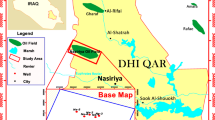Abstract
There are rich natural gas resources in the northwestern South China Sea deepwater areas, with poor degree of exploration. Because of the unique tectonic, sedimentary background of the region, velocity model building and time-depth conversion have been an important and difficult problem for a long time. Recent researches in this direction have revealed three major problems for deepwater areas, i.e., the way to determine error correction for drilling velocity, the optimization of velocity modeling, and the understanding and analysis of velocity variations in the slope areas. The present contribution proposes technical solutions to the problems: (1) velocity correction version can be established by analyzing the geology, reservoir, water depths and velocity spectrum characteristics; (2) a unified method can be adopted to analyze the velocity variation patterns in drilled pale structural positions; and (3) across-layer velocity is analyzed to establish the velocity model individually for each of the layers. Such a solution is applicable, as shown in an example from the northwestern South China Sea deepwater areas, in which an improved prediction precision is obtained.
Similar content being viewed by others
References
Chen Huanqing, Zhu Xiaomin, Zhang Gongcheng, et al. 2010. Characteristics of migration system of Paleogene Lingshui formation in the deepwater area in Qiongdongnan Basin. Acta Geologica Sinica (in Chinese), 84(1): 138–148
Dunne J, Beresford G, Kennett B. 1997. Model-based velocity analysis. Exploration Geophysics, 28(3): 349–354
Fliedner M M, Crawley S, Bevc D, et al. 2002. Velocity model building by wavefield-continuation imaging in the deepwater Gulf of Mexico. The Leading Edge, 21(12): 1232–1236
Fruehn J, Jones I F, Valler V, et al. 2008. Resolving near-seabed velocity anomalies: Deepwater offshore eastern India. Geophysics, 73(5): VE235–VE241
Han Dehua, Batzle M. 2005. Velocities of deepwater reservoir sands. 75th Annual International Meeting, SEG, Expanded Abstracts. 1501–1504
He Jiaxiong, Xia Bin, Zhang Shulin, et al. 2006. Migration-accumulation of gas under the abnormal high geotemperature and superpressure circumstance in Yinggehai Basin. Marine Geology & Quaternary Geology (in Chinese), 26(4): 81–89
Huang Yan, Lin Dechun, Bai Bing, et al. 2010. Challenges in presalt depth imaging of the deepwater Santos Basin, Brazil. The Leading Edge, 29(7): 820–825
Jiang Hua, Wang Hua, Xiao Jun, et al. 2009. Palaeogeomorphologic prediction of favorable zones: Take Fault ② of Qiongdongnan Basin as an example. Petroleum Exploration and Development (in Chinese), 36(4): 436–441
Keydar S, Koren Z, Kosloff D, et al. 1989. Optimum time-to-depth conversion. Geophysics, 54(8): 1001–1005
Liu Guangding. 2011. Intensify the research on continental margin of South China Sea. Chinese Journal of Geophysics (in Chinese), 54(12): 2991–2992
Liu Qifeng. 2003. Analysis and application of the velocity in imaging of seismic data and mapping of structure. Journal of Jianghan Petroleum University of Staff and Workers (in Chinese), 17(4): 52–54
Liu Aiqun, Chen Dianyuan, Li Qiang, et al. 2012. Progress of research on Qiongdongnan Basin slope fault zone velocity. Geophysical and Geochemical Exploration (in Chinese), 36(6): 922–927
Liu Aiqun, Chen Dianyuan, Li Qiang, et al. 2013. The problem of drilling velocity of exploration in Ying-qiong Basin and the method for its solution. Geophysical and Geochemical Exploration (in Chinese), 37(4): 603–607
Liu Aiqun, Li Qiang, Chen Dianyuan, et al. 2011. Natural gas exploration and velocity problems in the forecasting process and methodology. Progress in Geophysics (in Chinese), 26(4): 1312–1319
Liu Aiqun, Tong Chuanxin, Li Lin. 2008. Research of velocity analysis method and analysis of velocity influence factors in the east slope of Yinggehai basin. Progress in Geophysics (in Chinese), 23(6): 1909–1917
Liu Jangping, Yang Yongqing, Li Xiuzhong. 1999. The method for extracting velocity under the complex topographic condition and its analysis. Geophysical and Geochemical Exploration (in Chinese), 23(4): 259–264
Mancini F. 2013. A simplified workflow for accurate time-to-depth conversion using 3D grid tomography. The Leading Edge, 32(4): 430–434
Rüger A, Hale D. 2006. Meshing for velocity modeling and ray tracing in complex velocity fields. Geophysics, 71(1): U1–U11
Ren Jianye, Lei Chao, Wang Shan, et al. 2011. Tectonic stratigraphic framework of the Yinggehai-Qiongdongnan Basins and its implication for tectonics province division in South China Sea. Chinese Journal of Geophysics (in Chinese), 54(6): 1124–1137
Tian Shicheng, Chen Yongjin, Shi Fengcheng. 2006. Effect of abnormal pressure compartment in hydrocarbon accumulation. Earth Science Frontiers (in Chinese), 26(4): 81–89
Wang Deli, He Qiaodeng, Han Liguo. 2007. NMO velocity in fractured anisotropic media. Progress in Geophysics (in Chinese), 22(6): 1698–1705
Xie Jierui, Zhu Guangsheng, Qi Jiafu, et al. 2003. Application of sonic logging in average velocity field. Journal of Southwest Petroleum Institute (in Chinese), 25(1): 9–12
Yu Junfeng, Sun Zhipeng, Zhu Jitian. 2010. Cenozoic tectonic phases and their representing shapes in Songnan sag, Qiongdongnan Basin. Natural Gas Geoscience (in Chinese), 21(2): 281–288
Zhang Honglie, Deng Jinhua. 1996. Using seismic velocity spectrum information to find underground reservoirs. Geophysical Oil Prospecting (in Chinese), 31(2): 53–59
Zhang Faqiang, Wang Zhenliang, Wu Yasheng, et al. 2002. A method for eliminating geology factors of affecting compaction trendline: an example from Yinggehai Basin. Acta Sedimentologica Sinica (in Chinese), 20(2): 326–332
Zhao Min, Zhang Xiaobao, Ji Liming, et al. 2010. Characteristics of tectonic evolution in the Qiongdongnan Basin and brief discussion about its controlling on reservoirs. Natural Gas Geoscience (in Chinese), 21(3): 494–502
Author information
Authors and Affiliations
Corresponding author
Additional information
Foundation item: The National Twelfth Five Major Projects Subject-the deepwater area of northern South China Sea, rich hydrocarbon generation potential sag evaluation under contract No. 2011ZX05025-002.
Rights and permissions
About this article
Cite this article
Liu, A., Chen, D., Li, W. et al. Velocity model and time-depth conversion for the northwestern South China Sea deepwater areas. Acta Oceanol. Sin. 34, 56–61 (2015). https://doi.org/10.1007/s13131-015-0649-0
Received:
Accepted:
Published:
Issue Date:
DOI: https://doi.org/10.1007/s13131-015-0649-0




